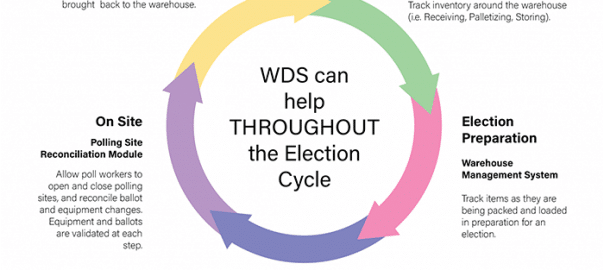The election systems industry depends on processes that are manual, repetitive, and filled with data entry. The ability to automate and streamline these processes, however, can drastically enhance any election process.
From planning properly before an election to ensuring a smooth process on voting day to securing all ballots once the precincts close, a robust software solution is critical throughout every phase in the election cycle.
Wireless Data Systems, Inc. (WDS) prides itself on building ground-up solutions that not only solve existing problems but foresee and avoid future challenges. Building election systems that wrap technology around election processes took a similar route as all of our software modules: we took a unique need to enhance and upgrade a process by learning the business and then using technology to improve as much as possible.
When we sat down with an election department it became clear that a custom module was necessary to meet their needs. After having looked for years for a solution to their election system woes, WDS designed a robust, customized solution unlike anything available before – TSX™ Elections.
Let’s break down our robust and feature-rich election system in detail.
Unmatched Accuracy for Ballot Ordering
WDS built an impressive ballot ordering suite by designing a grid format with columns for various quantities of ballots and accounting for registered and inactive voters. To further enhance accuracy, the system is able to utilize historical data to improve ballot ordering estimates.
Based on previous general, primary, and special election turnout, the system recommends ballot quantities for voters in that precinct. From there, users can increase or decrease the numbers by a percentage that makes sense. Plus, users are able to click on each line on the grid and change the quantity to account for variable factors, such as an anticipated increase in turnout due to a rally at a certain location.
In sum, the system looks at voters per precinct and calculates those numbers. Then, the user can apply things like historical data or percentage bumps based on precinct-specific variances.
The ability to manipulate the grid involves a series of what-if scenarios. By inputting and saving a number of ballot need scenarios, ascertaining exactly what to order becomes easy and accurate. Once a calculation and format is agreed upon, with the click of a button two files are generated:
- Excel file with all of the page styles needed per precinct
- Excel spreadsheet that has the ballot style sheets collated into finished ballots
Ballot page styles serve as a critical component to ballot ordering to ensure that the order entry module calculated how many pages and which style sheets were needed per precinct. With so many precinct-specific variable factors, TSX™ Elections is built to handle even the most complex scenarios.
Ballot Chain of Custody
The value of proper security in elections goes without saying. As such, TSX™ Elections was designed to incorporate an extensive chain of custody solution. Real-time validation of ballots, supplies, and equipment offers a level of peace of mind that is vital during election season.
Once the collated, sorted ballot packet comes off of the print line and is boxed, the barcode label is applied to the box. This barcode comes equipped with an intelligent number that includes all pertinent information about the ballots inside – event ID, election ID, precinct, party affiliation, and the total number of ballots.
As an option, the barcode may be scanned at the vendor site to be communicated to the TSX™ system to create an advanced shipping notice of the ballots heading to the election warehouse. Then, once they arrive at the warehouse the barcodes are scanned again. While 2-stage scanning is not always possible when performed, it safeguards the ballot tracking and confirms a smooth process from printing to storage.
Tracking the ballots through their entire lifecycle and chain of custody is imperative to the election cycle. TSX™ Elections features:
- Real-time GPS mapping and visibility of ballots
- Browser-based and scalable mobile applications
- On-premise or on cloud
- Customizable election systems to fit any elections department
In addition to meticulously tracking ballots, the TSX™ Elections system has the capacity to handle the additional ballots needed for the closing of registration for the election. Taking the estimated number of ballots ordered and comparing it to the registered voter counts, the system is able to alert management if more ballots will be needed for Election Day. Using the software, the user can select the style of ballot by precinct and party affiliation and order the quantity to add on to the current stock in the warehouse.
Enriched outbound tracking of the ballots is accomplished via GPS tracking. TSX™ Elections uses GPS coordinates, a smartphone application, geofencing, and breadcrumbs to make sure that the truck routes are verified and secure. Being able to track the delivery of the election ballots in real-time is essential to guaranteeing the polling sites have the right number of ballots needed for the expected voter turnout at that precinct.
Finally, it is important to note that the TSX™ Elections system is fully equipped to handle post-election compliance inquiries and auditing.
Enhanced Election Night Protection
Tracking voted ballots is never more important than it is post-election. When the polling sites close, all ballots (voted, unused, spoiled, and provisional) are handled with unmatched protection. The following retrieval process makes TSX™ Elections unlike anything else of its kind:
- Critical assets (ballots…plus thumb drives, signature documents, etc.) are picked up
- GPS satellite captures the driver’s cell phone location every 10 seconds to create the virtual breadcrumb trail
- Critical assets are delivered to the collection center or designated facility
- Critical assets are scanned at the collection center as they are received
- Everything is monitored and updated in real-time on the Election Night Dashboard, which can be accessed anywhere via the web
The Election Night Dashboard offers an easy-to-read interface providing management with real-time updates to allow for proactive responses as opposed to reactive emergencies. With fast and accurate tracking, retrieval, and storage of voted ballots, TSX™ Elections is ideal for easy retrieval for audits and/or recounts.
The TSX™ Elections system even offers real-time proof of pickup, retrieval, and storage for non-critical assets like chairs, tables, and laptops. While this is certainly not as critical as the ballots, thumb drives, and signature documents, it is still important to have proof that everything shipped out is returned.
Accountability, chain of custody, accuracy, and security are imperative components throughout each phase of the election cycle. TSX™ Elections provides that and more for elections departments both large and small.
Stay tuned for a future article about the supply chain model for all election assets and materials.




